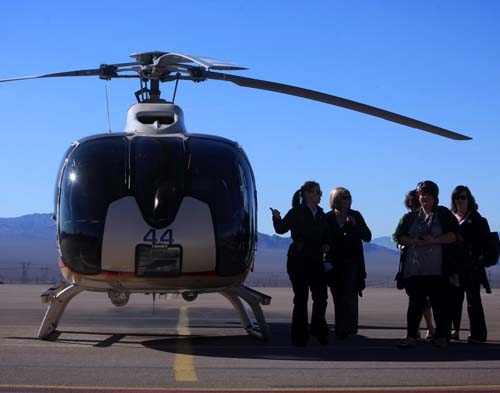Grand Canyon air tour operators say noise-reduction proposals could hurt business

Roger Clark likes to hike down into the Grand Canyon for a break from the continual hum, clash and clatter of city noise. However, the last time he took a hike down the canyon’s Hermit Trail, the whop-whop-whop sound of helicopters carrying tourists overhead destroyed the natural quiet.
“There was not a minute that I didn’t hear the sound of the helicopters,” Clark said.
Clark, air and energy program director at the Grand Canyon Trust, supports proposals released Wednesday by the National Park Service to restrict helicopter and fixed-wing aircraft tour flights over the natural wonder.
But Southern Nevada and Arizona companies that take visitors on canyon flights say the proposed flight restrictions could not come at a worse time for them and their 1,250 employees.
Nevada has the nation’s highest unemployment and highest home foreclosure rates. Americans struggling to hold onto their homes and jobs during the Great Recession have shown a reluctance to splurge on expensive trips to destinations like Las Vegas.
Las Vegas, however, is able to offer a two-for-one value because of its proximity to the Grand Canyon.
“Las Vegas has become the gateway to the Grand Canyon,” said Bryan Kroten, marketing director for Maverick Aviation Group, which employs 150 workers.
Kroten compared the canyon to the Great Wall of China in its iconic importance for foreign vacationers.
“It’s one of the seven natural wonders of the world,” he said. “We get a lot of customers that come to Las Vegas because of the Grand Canyon.”
It’s an important destination for international visitors and, in particular, those from United Kingdom, he said.
“Our international visitors like to get some of the outdoor excursions we have,” said Jeremy Handel, a spokesman for the Las Vegas Convention and Visitors Authority.
About 7 percent of the 37.5 million visitors to Las Vegas in 2009 visited the Grand Canyon during their Las Vegas vacations, according to the authority’s most recent study.
Tour flight operators fear the National Park Service proposals on flight noise reductions could reduce those numbers.
“The Park Service has done the unthinkable but not the unexpected; it has broken its public promise to the air tour community to not propose measures designed to drive the industry, along with many jobs, out of existence in Southern Nevada and Northern Arizona — which this will do,” Steve Bassett, president of the United States Air Tour Association, said.
“It took nearly two decades to reach (a noise reduction) milestone but responsible and dedicated air tour operators finally achieved the Park Service’s long-standing definition of substantial restoration of natural quiet,” he said. “Now that the goal has been reached, the Park Service wants to raise the bar. That is neither appropriate nor fair. “
Clark, who began yearly treks through the canyon in 1961, takes a cynical view of the industry’s complaints about noise restrictions.
“Every time restrictions are proposed, the tour industry says (the restrictions) will put them out of business,” Clark said. “Not only have they not gone out of business, they’ve thrived over the last 20 years.”
In recent years, aircraft noise has gotten worse in some areas of the canyon. In other areas, it has lessened, he said.
“Overall, it’s not meeting the objective of restoring natural quiet to the canyon,” he said.
The Grand Canyon Trust believes more can be done to restore natural quiet to the canyon, he said.
The park service’s preferred alternative would reduce aircraft noise, move routes away from many cultural and natural areas and set a cap of 364 air tour flights daily.
The rule would require higher flight altitudes near North Rim viewpoints, establish one hour of quiet time before sunset and after sunrise daily and mandate conversion to quiet technology aircraft within 10 years.
Contact reporter John G. Edwards at
jedwards@reviewjournal.com or 702-383-0420.